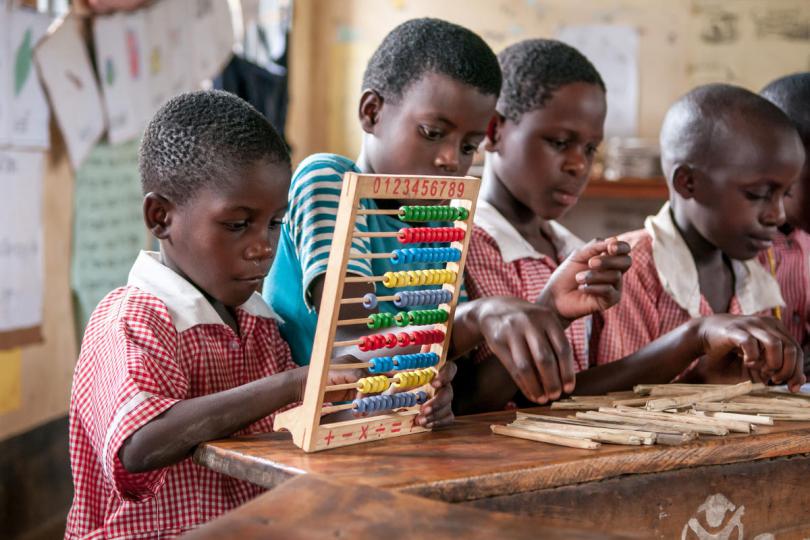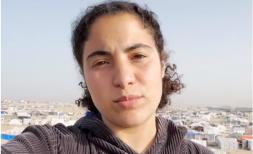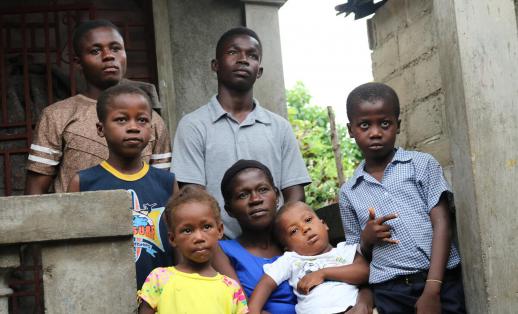Transforming Education Summit: Warm words and good intentions, but the education crisis requires bolder action

Nepali children hold open an illustrated storybooks written in their local language of Maithili inside an early learning center.
More than two years after schools around the world shut their doors in response to the COVID-19 pandemic, the Transforming Education Summit (TES) in September couldn’t have been more timely. Global education was in dire crisis before the pandemic, with millions of children around the world out of school and not learning from a quality, safe and inclusive education. With the extended school closures, disparities in access to online and distance learning, inadequate resources to support students to return to school, and the impacts of conflict and climate change, the learning outcomes of the poorest and most marginalised children are now even more at threat.
The UN Secretary-General, Antonio Guterres’ announcement in December 2021 that he would convene the Transforming Education Summit to “forge a common vision for education” and “accelerate progress towards the achievement of Sustainable Development Goal 4” was a welcome signal that getting education back on track was of the utmost importance for the international community.
The summit, held last month during the annual UN General Assembly, undoubtedly shone a spotlight on education. Yet it was a missed opportunity to truly bring about the transformative and bold action that so many children around the world so badly need.
What were the outcomes from the Summit?
New and action-orientated commitments arising from the TES were limited. Six official ‘Calls to Action’ were published, stemming from a series of consultations and development of several discussion papers, which were important in creating a better and joint understanding of the deepening education crisis. But there is little clarity on what happens next to put these words into action, nor is it clear exactly who has endorsed the calls to action.
113 countries also submitted statements of commitment at the TES. The Secretary General’s Vision Statement encourages “countries that have registered a National Statement of Commitment can translate those commitments into a clear road map for transformation”. But many governments simply re-affirmed existing commitments, and there were far fewer significant new commitments.
Ahead of the Transforming Education Pre-Summit in Paris, Save the Children published a blog setting out what we wanted to see from the Summit in order to deem it a success. Here we give our assessment on how well the Summit performed against these criteria:
1. Inclusivity and child participation must be at the heart of the summit
We wrote back in July that no summit about the education and futures of children and young people should take place without their meaningful participation. Youth were indeed involved throughout the process, at the pre-summit and at the summit itself. But to our knowledge, very few under 18s were involved in the process leading up to the TES or in the Summit itself, either in-person or virtually. Where youth were involved, it wasn’t clear that these were youth representing marginalised and/or under-represented groups.
The Youth Declaration was the strongest appeal for action made at the Summit. It represents a real testament to the power of voices who have been directly impacted by the learning crisis and want to see action. In their own words: “For too long we have been excluded or only tokenistically included in the policy and decision-making processes affecting our lives, livelihoods and futures. In transforming education, we demand that our voices are heard, our lived experiences valued, our demands addressed, and our efforts, leadership, and agency acknowledged.”
The Youth Declaration was arguably more ambitious and urgent than the UNSG’s Vision Statement. The vision statement spells out the scale of the crisis facing education and the key ingredients for transformation, but falls short in responding to the urgency of this crisis. It is not an actionable road map for accelerating progress towards SDG4.
It’s essential that follow up to the Youth Declaration is not side-lined, and that youth representatives from the SDG4 Youth network play a meaningful role with the SDG4 High-Level Steering Committee in creating an action plan to take forwards the Youth Declaration. It is important that this process also includes participation from children under the age of 18.

Save the Children supports non-formal schools in rural parts of Uganda. The NORAD-funded programme has constructed new classrooms and teachers' accommodation; trained teachers on new participatory learning approaches, such as 'Literacy Boost' and 'Numeracy Boost'. Andrew Pacutho / Save the Children
2. Recognise the challenges facing global education & recommit to foundational learning
The challenges facing education were certainly well explored and set out in the discussion papers that were produced in advance of the Summit. But given that the Summit was in-part convened in response to the global learning crisis, it was disappointing that only 40% of countries prioritised measures to address learning loss in the national statements of commitment.
It was therefore certainly welcomed that one of the Calls to Action focused on foundational learning, given that the World Bank estimates that nearly 70% of children in low- and middle-income countries are unable to read a simple text by the age of 10. The Secretary-General's Vision Statement similarly had a welcome focus on foundational learning – literacy, numeracy and socio-emotional learning.
It is essential that this Call to Action, along with the others five Calls to Action, are turned into clear, measurable and time-bound actions, with clear accountability for governments and international actors.
3. The summit must plan for future crises
Children’s access to education is under serious threat from the intersecting and ongoing crises of climate change, conflict and COVID-19. We noted back in June that any commitments made as part of thorough national consultation processes should include anticipatory planning which future-proofs education systems against new global health crises, conflict, economic shocks, and sudden and slow-onset disasters linked to climate change.
It was welcomed that education in emergencies was a key theme of the Summit, and that one of the Calls to Action focused on education in crisis situations , and that this document recognises the need to build the resilience of education systems in response to crises. Many countries in their statements of commitment also underlined this need, specifically by investing in digital learning to prepare for future shocks, and strengthen capacity-building in disaster-risk reduction and climate change adaptation within the education sector.
4. The summit must build on existing momentum
We noted that whilst this Summit was welcomed, it was important that any commitments or declarations coming out of it were clearly building on momentum from existing agreed commitments - such as the Kenyatta Declaration, Incheon Declaration and the Safe Schools Declaration, to name just a few.
It was certainly good to hear that President Akufo-Addo of Ghana is carrying forward the Kenyatta Declaration – this is crucial to maintaining momentum of domestic education financing.
But on the whole, there has been little in the way of updates on how governments are delivering on existing commitments – the G7 Girls’ Education Declaration being one of the most recent examples.
5. Leaders must put their money where it matters
In the end, none of the commitments made at the TES will amount to anything unless there is more and better funding for education – the global financing gap to meet SDG4 is estimated to be as high as $200 billion annually. Yet as Save the Children noted in a recent briefing, one-third of low- and lower middle-income countries are spending more on external debt servicing than they are on children’s education.
At TES, there was the formal launch of the International Finance Facility for Education, a loans-based mechanism that will support education in lower-middle income countries. This is welcomed, since these countries are home to some of the largest numbers of out-of-school children. There was also new funding announced for UNGEI and the Education Cannot Wait fund. These announcements are also welcomed, but are still a drop in the ocean compared to what is needed to fill the financing gap.

Ladan*, 10, and Sahra*, 10, with their friends at a Child Friendly Space in Puntland, Somalia. Mustafa Saeed / Save the Children
What’s next?
As Leonardo Garnier, Special Advisor to the Summit, said in the first post-Summit briefing: “The summit is not about the event we had in September, but about the actions that follow in every country and globally” - and in the same briefing, several Member States called for more clarity on the process to carry forward the Calls to Action and Commitments. Without this, it is difficult to see how the Summit will translate into meaningful and impactful change for children’s education.
We also welcome Special Advisor highlighting financing as the “biggest bottleneck we face”. There are promising early steps on this front, with the announcement of 5 ‘champion countries’, the call from 12 African Heads of State for an African Union (AU) “Year of Education”, and President Akufo-Addo of Ghana becoming a GPE Domestic Education Financing Champion. But with “75% of the children of the world being educated with less than 10% of the global investment in education”, it’s clear that we need greater and continued political leadership, if education is ever to achieve the levels of financing that other areas of development receive.
So, it is imperative for all those who care about the fight for children’s right to an education and its role in achieving sustainable development, to build on the momentum achieved from the summit and demand accountability for all the warm words and good intentions. We must ensure that we leverage key moments to push forward the TES agenda, with Deputy Secretary-General Amina Mohammed already highlighting the G20, COP27, HLPF and the SDG Summit. Save the Children commits to playing our part in working with and demanding actions from key decision-makers.
We call on the SDG4 High-Level Steering Committee to explain how it intends to follow-up on the TES at its December meeting – what priority areas will it be holding to account? How will calls to action be endorsed by member states and implementation transparently be tracked?
It’s essential to ensure that the SDG Summit (2023) and Summit of the Future (2024) does a better job at including under 18s in a meaningful way. We’ve heard that Summit of the Future will be an opportunity to follow-up on TES. The outcome document of this Summit should reflect progress achieved in delivering on commitments made at the TES and provide a clear actionable plan to 2030.
The mission to truly transform education so that it delivers quality education for all children is an essential but challenging endeavour. It is not only critical for children themselves but for society as a whole. The futures of this generation of children and young people, as well as subsequent generations, depend on what we do now. Enough words, time for action.
With contributions from Beathe Ogard, Bonnie Berry, James Cox, Emma Wagner, Carly Munnelly and Oliver Mawhinney.







